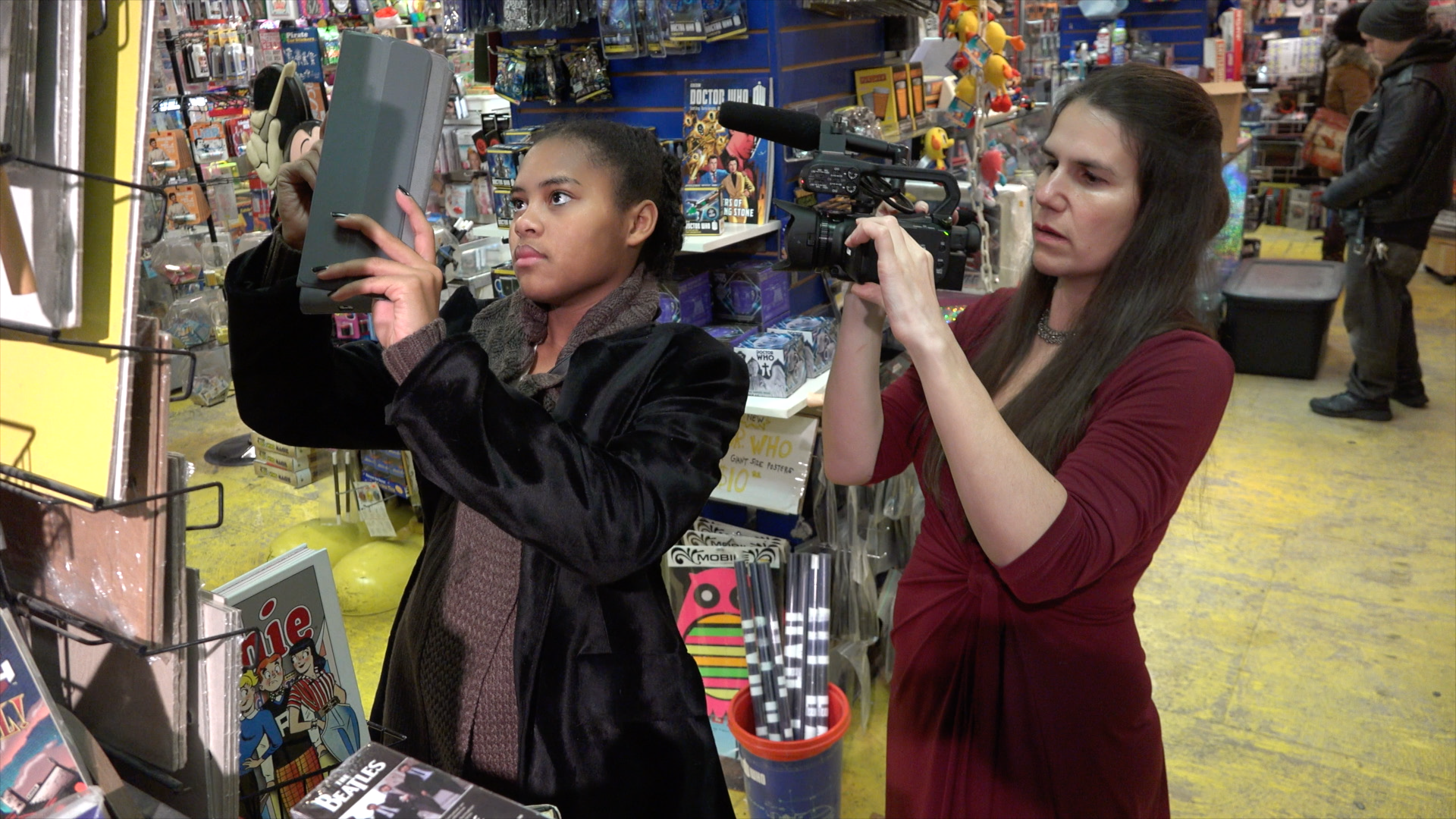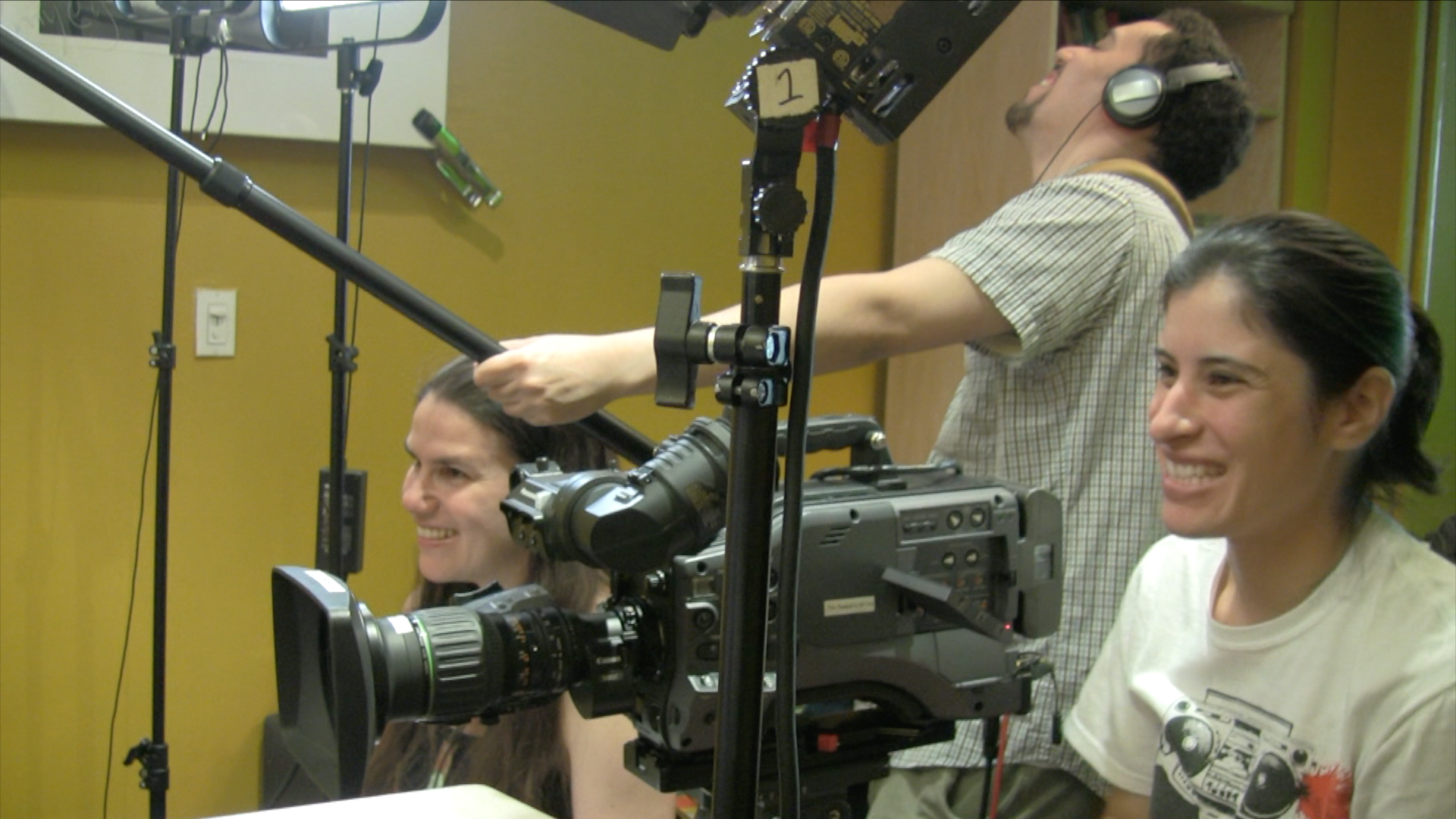Alexandra Hidalgo, Cámara Retórica: A Feminist Filmmaking Methodology (Computers and Composition Digital P/Utah State UP, 2017)
Ana Milena Ribero, Oregon State University
(Published December 13, 2017)
Alexandra Hidalgo’s Cámara Retórica: A Feminist Filmmaking Methodology for Rhetoric and Composition confronts an exclusionary tendency that continues to plague much film and video work: the assumption that women of color do not belong behind the camera. In her groundbreaking video book, Hidalgo centers women filmmakers and feminist filmmaking praxis to not only provide a much-needed primer for filmmaking in Rhetoric and Composition, but also to ensure that as the discipline makes moving-image work an essential part of our scholarship we avoid the homogenizing ethos of mainstream filmmaking. In the brief textual introduction to the video book, Hidalgo describes one of her goals in creating Cámara Retórica: “I hope that by the time you finish watching this video book, the idea that women know how to make films and that it is natural for them to do so will have seeped into your conscious and subconscious mind in the same way that images of men behind the camera have been there for as long as you’ve been consuming media.” Not only does Hidalgo normalize the idea that women belong in all aspects of filmmaking, she also outlines and practices a feminist filmmaking methodology that advocates for feminist praxis in Rhetoric and Composition.

Figure 1. Normalizing women behind the camera.
The first video book about filmmaking in the discipline, Cámara Retórica gives scholars the language with which to understand how filmmaking can inform Rhetoric and Composition and vice versa. Incorporating her own experiences as a feminist filmmaker with relevant scholarship on the subject, Hidalgo presents a robust landscape of filmmaking in the discipline. Her passion for her craft is evident throughout the video book, though she does not conceal the difficulty of academic filmmaking: “Making moving images is an often arduous, frustrating, and seemingly endless task but as I show here, it is also one of the most enriching and exhilarating creative and intellectual practices available to us.” By positioning filmmaking as an intellectually rigorous and physically demanding practice, Hidalgo advocates for Rhetoric and Composition scholars to value film and video production as an essential part of our scholarship and to count such work in promotion and tenure cases.
The audience for this book is what Hidalgo calls beginner lifers and casual offenders. Casual offenders are “scholars who have produced a couple of films and videos, or published an essay touching upon film and video production” but who do not make film and video making central to their scholarship. Lifers, according to Hidalgo, “see moving images as either their medium of choice or a medium they aim to work in throughout their careers.” Hidalgo is a self-described lifer.
In six video chapters, each of approximately 25-30 minutes in length, Cámara Retórica covers an ambitious amount of territory. The chapters outline the principles of feminist filmmaking, construct a taxonomy of film and video work within the discipline, recommend production quality guidelines for rhetoricians’ film and video productions, provide suggestions for making moving-image work count towards tenure and promotion, and reflect on the future of film and video in the discipline. Its critical engagement with filmmaking along with its practical applications make Cámara Retórica both a scholarly reflection on the value of film and video to the discipline and a sort of guidebook for filmmakers in the field.
Whether readers engage with Cámara Retórica as a scholarly text or as a practical guide (or both), Hidalgo’s vision for filmmaking in Rhetoric and Composition is clear—a vision anchored by the principles of feminist filmmaking that Cámara Retórica not only outlines but also exemplifies. As a Rhetoric and Composition scholar whose foray into digital scholarship is still nascent, I was particularly drawn to Hidalgo’s notion of the ethics of interdependence, specially given our discipline’s long-standing consideration of how writer, reader, text, and context influence one another. While Hidalgo acknowledges that the work of a director often involves making decisions that silence the ideas of others, the ethics of interdependence considers all participants as equally important to the creative process of filmmaking. Further, the ethics of interdependence creates benefits for all who are involved in the project by, for example, training crewmembers in direction and production or giving documentary participants final decision-making power on how they are portrayed in the film. Such feminist praxis is clearly important to the discipline at an ideological level since Rhetoric and Composition as a humanistic field values the people our work involves. Hidalgo, however, also provides a more pragmatic logic: “The ethics of interdependence, which result in participants who are satisfied with how they’re represented, are particularly important for rhetoricians and for the institutions that house us, helping us avoid anywhere from minor resentment to libel lawsuits.” This mode of thinking is illustrative of the line that Cámara Retórica blurs between being a thoughtful work that provides a vision for filmmaking in Rhetoric and Composition and being a pragmatic text that helps scholars deal with the nitty gritty of moving-image scholarship.

Figure 2. The ethics of interdependence
Also noteworthy are Hidalgo’s guidelines for rhetoricians’ film and video production. She writes, “We don’t need to make the kind of professional moving images that play at multiplexes, but our work does need to be of a certain quality.” At the heart of Hidalgo’s guidelines is the idea that film and video work needs to be rhetorically appropriate; to this end, Cámara Retórica provides guidelines for cinematography, lighting, framing, sound, music, transitions, and text that forego complicated technical knowledge and are based instead on rhetorical awareness of how images, sounds, and text work together to form successful arguments. The guidelines are simple, making them accessible to beginners, and set up a minimum standard of quality for films and videos in Rhetoric and Composition. For example, when it comes to camera work, Hidalgo suggests that any camera movement should be purposeful. Unnecessary camera movements, such as “random zooming, pans, and tilts,” can distract the viewer and detract from the video’s aim. When it comes to framing of the shot, the subject of the shot (e.g., the person being interviewed in a documentary) should take up a significant portion of the frame so that viewers clearly identify the scene’s focus. While these guidelines might seem commonsensical, they provide a clear set of standards that can be particularly useful for beginners with no or little experience in making moving images.
But perhaps the most useful aspect of this video book for the aspiring filmmaker in Rhetoric and Composition is Chapter 5 – “Making Our Film and Video Work Count for Tenure and Promotion.” If Rhetoric and Composition is going to consider filmmaking a worthwhile academic pursuit, as Hidalgo advocates, then moving-image work must be legible in promotion and tenure cases. Yet, departments rooted in print culture do not often recognize the intellectual value of digital work or know how to assess it when it comes to promotion and tenure. Hidalgo argues that through “hustle and creative problem solving,” academic filmmakers can make their films and videos contribute to their promotion and tenure cases while simultaneously transforming our departments into places that value this type of work. In addition to the publication venues that print-based academics are accustomed to, Hidalgo suggests making film and video work visible in print-rooted departments through publications in digital journals, screenings at film festivals, and successful applications to competitive grants (for which, Hidalgo claims, the cost of filmmaking is a lot easier to explain than it is in much print-based work in Rhetoric and Composition).
Lastly, I would be remiss if I didn’t address Cámara Retórica’s genre. In Cámara Retórica, Hidalgo is inventing a new genre in Rhetoric and Composition—the video book. This video book provides a deep engagement with a topic and is divided into chapters, much like a print book, but incorporates moving images in doing so. Hidalgo is the sole narrator, threading quotations into her text like in a print book. Unlike a documentary that features different speakers and voices, in this video book we hear the words of other scholars and filmmakers through Hidalgo’s narration. Along with the narration, we see different types of moving images. Some of the moving images are clearly Hidalgo’s own, which include videos of her family, footage of academic conferences and presentations, and shots of women making films. We also see the work of other filmmakers both in and out of Rhetoric and Composition weaved in with Hidalgo’s footage to create a rich tapestry of moving images and a contextual landscape for Hidalgo’s argument about academic feminist filmmaking. The images play the role of a background videotrack (akin to a soundtrack)—complementing the spoken text that remains the central focus. This is perhaps my only critique of Cámara Retórica. Even though it seeks to find a central place for the moving image in Rhetoric and Composition, Cámara Retórica remains a text that privileges alphabetic meaning-making (although we hear the words rather than read them). Hidalgo provides visual themes that are supposed to contribute to the video book’s message (for example, images of children and toys are supposed to convey the sense of curiosity, play, and experimentation that filmmaking elicits). However, I found the themes and their explanations not completely satisfying, as they are in large part peripheral to the main arguments of the work. As I watched Cámara Retórica, I wondered what this video book would look like if it truly de-centered alphanumeric meaning-making. Perhaps Sarah Arroyo and Bahareh Alaei’s “The Dancing Floor,” a video essay that Hidalgo asserts “makes complex arguments through every one of its layers,” can provide a more apt example of de-centering alphabetic literacies, as images seem to contribute equally to meaning-making as words do.

Figure 3. The theme of children and toys
Despite its ultimate reliance on alphanumeric meaning-making, Cámara Retórica makes a cogent argument for the importance of moving-image work in the discipline. Thought-provoking and engaging, the video book provides the contextualizing background, filmmaking guidelines, and friendly encouragement that beginner filmmakers in Rhetoric and Composition need. In Cámara Retórica, Hidalgo positions herself as mentor to the uninitiated, confirming her place as a pioneer in and advocate for filmmaking in Rhetoric and Composition.